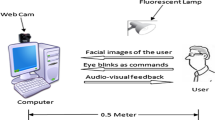Abstract
In the area of human–computer interaction, contemporary head tracking systems are often used as camera-based mouse emulators. While head movement detection provides the basis for related mouse shifting and positioning, standard click actions are usually emulated using stillness counter techniques such as Dwell Click (DC). However, these techniques can be a source of enlarged interaction burden, as users often have to struggle with time-consuming repetitive UI actions. This paper proposes a novel version of Blink Click (BC) action called B2C, based on double eye blink detection, as a valuable supplement for faster mouse click emulation. The integration of the proposed BC action into an existing head tracking system is presented, and implementation issues are thoroughly analyzed. Usability testing of the proposed B2C interaction model, along with the already embedded DC model, has been carried out, providing both quantitative and qualitative outcomes. The results show efficiency improvement as well as a higher level of users’ satisfaction when using the proposed version of BC, thus making it a strong candidate to become a standard feature within the computer-vision-based mouse emulation.
















Similar content being viewed by others
References
Stephanidis, C.: Editorial. Univ. Access Inf. Soc. 1(1), 1–3 (2001)
Shneiderman, B.: Universal usability: pushing human–computer interaction research to empower every citizen. Commun. ACM 43(5), 85–91 (2000)
Chau, M., Betke, M.: Real Time Eye Tracking and Blink Detection with USB Cameras. Technical Report No. 2005–12, Boston University, Computer Science Department (2005)
Mauri, C., Granollers, T., Lores, J., Garcia, M.: Computer vision interaction for people with severe movement restrictions. Hum. Technol. 2(1), 38–54 (2006)
Bates, R.: Enhancing the Performance of Eye and Head Mice: A Validated Assessment Method and an Investigation into the Performance of Eye and Head Based Assistive Technology Pointing Devices. Dissertation, De Montfort University, pp. 1–348 (2006)
Border, J.: Exploring Empirical Guidelines for Selecting Computer Assistive Technology for People with Disabilities. M.Sc. thesis, Wright State University, pp. 1–167 (2011)
Enable Viacam (eViacam). http://eviacam.sourceforge.net/. Retrieved Sept 2013
Jacob, R.: The use of eye movements in human–computer interaction techniques: what you look at is what you get. ACM Trans. Inf. Syst. 9(2), 152–169 (1991)
Grauman, K., Betke, M., Lombardi, J., Gips, J., Bradski, G.R.: Communication via eye blinks and eyebrow raises: video-based human–computer interfaces. Univ. Access Inf. Soc. 2(4), 359–373 (2003)
Inference Group: The Dasher Project. http://www.inference.phy.cam.ac.uk/dasher/. Retrieved Sept 2013
Drewes, H.: Eye Gaze Tracking for Human Computer Interaction. Dissertation, Ludwig Maximilians University Munich, pp. 1–164 (2010)
Missimer, E., Betke, M.: Blink and wink detection for mouse pointer control. In: Proceedings of the 3rd International Conference on Pervasive Technologies Related to Assistive Environments (PETRA’10), pp. 1–8, ACM, New York, NY, USA (2010)
Smith, P., Shah, M., Lobo, N.V.: Monitoring head/eye motion for driver alertness with one camera. In: Proceedings of the 15th International Conference on Pattern Recognition, vol. 4 (ICPR’00), pp. 636–642, IEEE Computer Society, Washington, DC, USA (2000)
Picot, A., Caplier, A., Charbonnier, S.: Comparison between EOG and high frame rate camera for drowsiness detection. In: Proceedings of the Workshop on Applications of Computer Vision (WACV’09), pp. 1–6, IEEE Computer Society, Washington, DC, USA (2009)
Battista, J.: A drowsiness and point of attention monitoring system for driver vigilance. In: Proceedings of the Intelligent Transportation Systems Conference (ITSC’07), pp. 702–708, IEEE Computer Society, Washington, DC, USA (2007)
Miluzzo, E., Wang, T., Campbell, A.T.: EyePhone: activating mobile phones with your eyes. In: Proceedings of the 2nd ACM SIGCOMM Workshop on Networking, Systems, and Applications on Mobile Handhelds (MobiHeld’10), pp. 15–20, ACM, New York, NY, USA (2010)
Han, S., Yang, S., Kim, J., Gerla, M.: EyeGuardian: A framework of eye tracking and blink detection for mobile device users. In: Proceedings of the 12th Workshop on Mobile Computing Systems and Applications (HotMobile’12), pp. 1–6, ACM, New York, NY, USA (2012)
Ashtiani, B., MacKenzie, I.S.: BlinkWrite2: An improved text entry method using eye blinks. In: Proceedings of the 2010 Symposium on Eye-Tracking Research and Applications (ETRA’10), pp. 339–345, ACM, New York, NY, USA (2010)
Krolak, A., Strumillo, P.: Eye-blink detection system for human–computer interaction. Univ. Access Inf. Soc. 11(4), 409–419 (2012)
Open Source Computer Vision Library. http://sourceforge.net/projects/opencvlibrary/. Retrieved Sept 2013
MacKenzie, I.S.: Human–Computer Interaction: An Empirical Research Perspective. Morgan Kaufmann, Los Altos, CA (2013)
Hwang, W., Salvendy, G.: Number of people required for usability evaluation: the 10 ± 2 rule. Commun. ACM 53(5), 130–133 (2010)
APASLab. http://apaslab.riteh.hr/download/b2c/. Retrieved Sept 2013
Author information
Authors and Affiliations
Corresponding author
Rights and permissions
About this article
Cite this article
Krapic, L., Lenac, K. & Ljubic, S. Integrating Blink Click interaction into a head tracking system: implementation and usability issues. Univ Access Inf Soc 14, 247–264 (2015). https://doi.org/10.1007/s10209-013-0343-y
Published:
Issue Date:
DOI: https://doi.org/10.1007/s10209-013-0343-y




